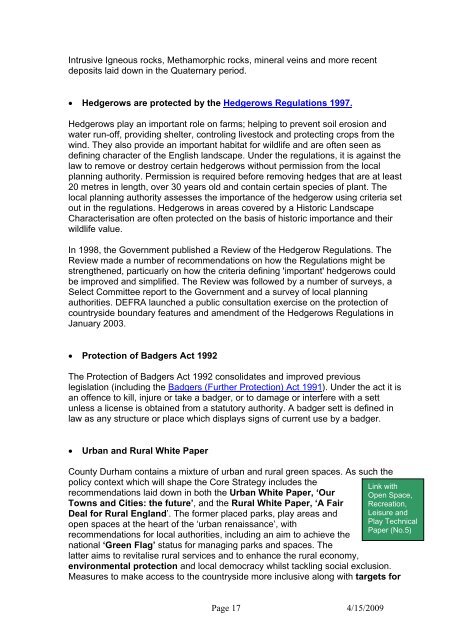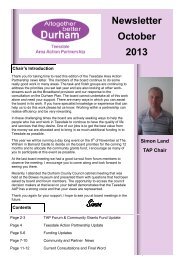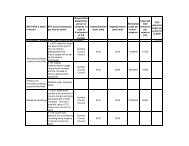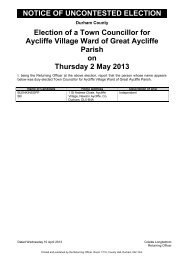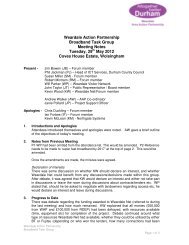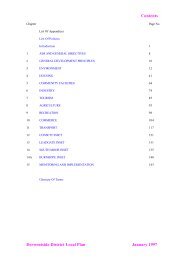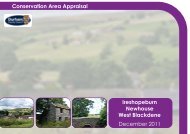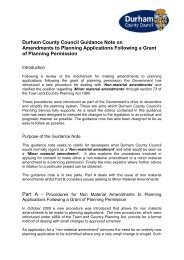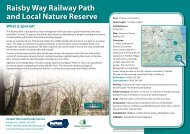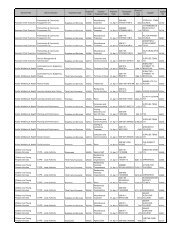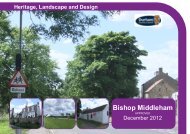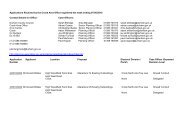SECTION 3.0 - Durham County Council
SECTION 3.0 - Durham County Council
SECTION 3.0 - Durham County Council
Create successful ePaper yourself
Turn your PDF publications into a flip-book with our unique Google optimized e-Paper software.
Intrusive Igneous rocks, Methamorphic rocks, mineral veins and more recent<br />
deposits laid down in the Quaternary<br />
period.<br />
• Hedgerows are protected by the Hedgerows Regulations 1997.<br />
Hedgerows play an important role on farms; helping to prevent soil erosion and<br />
water run-off, providing shelter, controling livestock and protecting crops from the<br />
wind. They also provide an important habitat for wildlife and are often seen as<br />
defining character of the English landscape. Under the regulations, it is against the<br />
law to remove or destroy certain hedgerows without permission from the local<br />
planning authority. Permission is required before removing hedges that are at least<br />
20 metres in length, over 30 years old and contain certain species of plant. The<br />
local planning authority assesses the importance of the hedgerow using criteria set<br />
out in the regulations. Hedgerows in areas covered by a Historic Landscape<br />
Characterisation are often protected on the basis of historic importance and their<br />
wildlife value.<br />
In 1998, the Government published a Review of the Hedgerow Regulations. The<br />
Review made a number of recommendations on how the Regulations might be<br />
strengthened, particuarly on how the criteria defining 'important' hedgerows could<br />
be improved and simplified. The Review was followed by a number of surveys, a<br />
Select Committee report to the Government and a survey of local planning<br />
authorities. DEFRA launched a public consultation exercise on the protection of<br />
countryside boundary features and amendment of the Hedgerows Regulations in<br />
January 2003.<br />
• Protection of Badgers Act 1992<br />
The Protection of Badgers Act 1992 consolidates and improved previous<br />
legislation<br />
(including the Badgers (Further Protection) Act 1991).<br />
Under the act it is<br />
an offence to kill, injure or take a badger, or to damage or interfere with a sett<br />
unless a license is obtained from a statutory authority. A badger sett is defined in<br />
law as any structure or place which displays signs of current use by a badger.<br />
• Urban and Rural White Paper<br />
<strong>County</strong><br />
<strong>Durham</strong> contains a mixture of urban and rural green spaces. As such the<br />
policy<br />
context which will shape the Core Strategy includes the<br />
Link with<br />
recommendations laid down in both the Urban White Paper, ‘Our Open Space,<br />
Towns<br />
and Cities: the future’, and the Rural White Paper, ‘A Fair Recreation,<br />
Deal for Rural England’. The former placed parks, play areas and Leisure and<br />
open spaces at the heart of the ‘urban renaissance’, with<br />
Play<br />
Technical<br />
Paper (No.5)<br />
recommendations for local authorities, including an aim to achieve the<br />
national ‘Green Flag’ status for managing parks and spaces. The<br />
latter aims to revitalise rural services and to enhance the rural economy,<br />
environmental<br />
protection and local democracy whilst tackling social exclusion.<br />
Measures to make access to the countryside more inclusive along with targets for<br />
Page 17 4/15/2009


